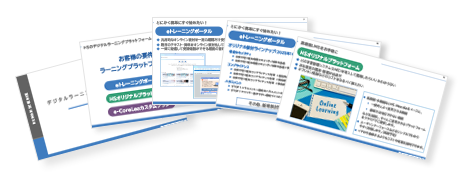2022.06.24
Five Key Points of the 2022 Revised Childcare and Family Care Leave Law Explained Clearly
In today's society, where the declining birthrate and aging population are prominent issues, balancing childcare and caregiving with work is a common concern for many. A supportive system that alleviates such anxieties is the "Childcare and Family Care Leave Law."
The Childcare and Family Care Leave Law was revised in 2021 and has been implemented in phases starting from April 1, 2022.
In this article, we will thoroughly explain the definition of the Childcare and Family Care Leave Act, the five amendments revised in 2021, and how to inform employees about these amendments. We hope this article serves as a helpful resource for those who need childcare or family care leave.
Table of Contents
1. Background of the 2021 Amendment to the Child Care and Family Care Leave Act
2. Six Key Points of the Child Care and Family Care Leave Act Amendments to Note
① Mandatory establishment of an employment environment that makes it easier to take child care leave (Effective April 1, 2022)
② Mandatory measures for individual notification and confirmation of intentions regarding the system (Effective April 1, 2022)
③ Relaxation of eligibility requirements for fixed-term employees to take child care and family care leave (Effective April 1, 2022)
④ Establishment of the Postpartum Paternity Leave System (Child Care Leave System at Birth) (Effective October 1, 2022)
⑤ Flexibility in the division of child care leave and the start date of leave (Effective October 1, 2022)
⑥ Mandatory publication of child care leave acquisition status (Effective April 1, 2023)
3. How to Inform Employees About the Amendments to the Child Care and Family Care Leave Act
1. Background of the 2021 Amendment to the Child Care and Family Care Leave Law
The Child Care and Family Care Leave Law has the official name "Law Concerning the Welfare of Workers Who Take Child Care Leave, Family Care Leave, etc." It is a law established to create a workplace environment that allows working individuals to balance their jobs with child-rearing or family care without having to leave their companies. The Child Care and Family Care Leave Law has previously established support systems such as the following.
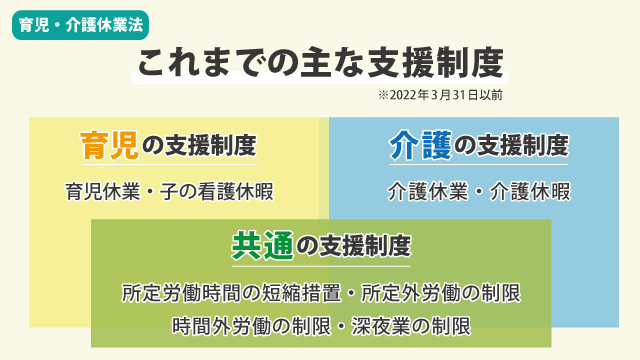
Reference: https://www.mhlw.go.jp/content/11909000/000355358.pdf
In June 2021, the Child Care and Family Care Leave Law was amended. This amendment prominently featured the establishment of "Postpartum Paternity Leave" to encourage men to take child care leave, as well as the obligation to create an environment that makes it easier to take child care leave. What factors were behind this change?
● Background of the Revision of the Child Care and Family Care Leave Law
According to the "Basic Survey on Employment Equality" announced by the Ministry of Health, Labour and Welfare, the rate of childcare leave taken by women remains in the 80% range, while for men it is 12.65%, showing a significant gender gap. Although recent reforms in work styles have led to an increase in the rate of childcare leave taken by men, it is undeniable that it remains at a low level.
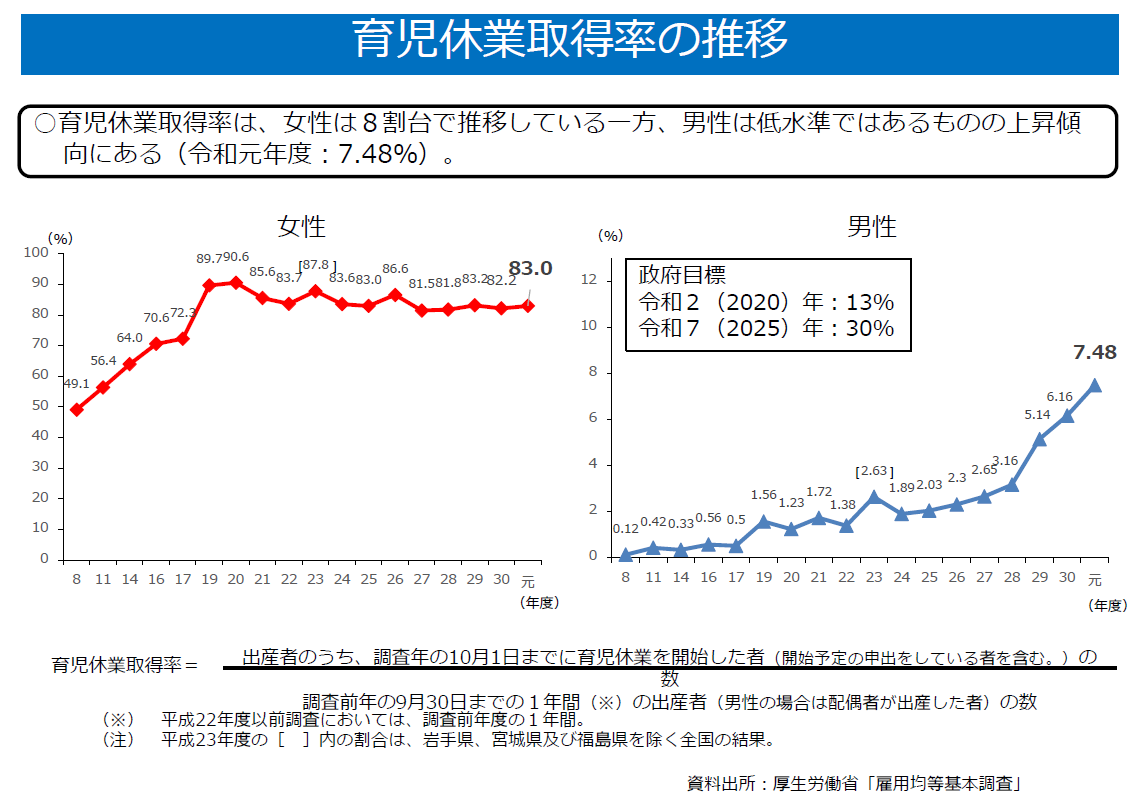
Source: https://www.mhlw.go.jp/content/11901000/000676815.pdf
Additionally, according to the "15th Basic Survey on Birth Trends" by the National Institute of Population and Social Security Research, it can be understood that nearly 50% of women choose to resign due to childbirth and childcare.
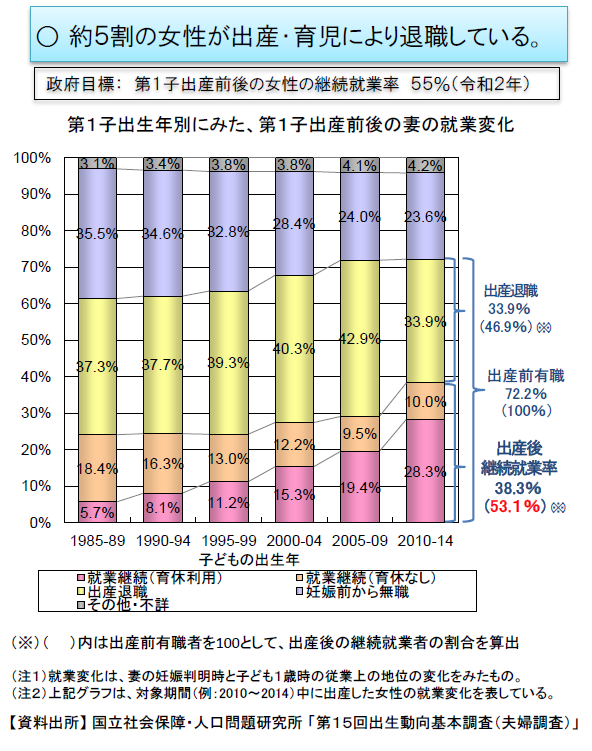
Source: https://www.mhlw.go.jp/content/11901000/000676815.pdf
From this data, it can be seen that while the trend of men taking parental leave is increasing, the situation where "women primarily handle childcare and housework" is still prevalent.
On the other hand, among the men who wished to take leave for childcare, about 40% were unable to utilize the parental leave system, indicating that the current system is not sufficiently established to support men's leave acquisition.
In light of this background, the "Outline for Measures to Address the Declining Birthrate Society" decided by the Cabinet in May 2020 included content such as "comprehensively promoting initiatives to encourage men to take childcare leave and participate in childcare, including individual awareness and publicity of childcare leave systems for workers, creating an environment that makes it easier to take time off for childcare, and examining frameworks to promote leave immediately after the spouse's childbirth." and "considering measures to make it easier for fixed-term employees to take childcare leave."
As a result, this led to the amendment of the Child Care and Family Care Leave Law in 2021.
2. Childcare and Family Care Leave Law: 6 Key Points of Important Revisions
From here, we will focus on the details of the amendments. This legal revision aims to improve the environment so that anyone, regardless of gender, can easily take parental leave, with the parental leave system for new fathers (birth-related childcare leave system) as a representative example.
Main Points of the Amendments to the Childcare and Family Care Leave Act
① Mandatory establishment of an employment environment that makes it easier to take childcare leave (Effective April 1, 2022)
② Mandatory individual notification and confirmation of intent regarding the system (Effective April 1, 2022)
③ Relaxation of eligibility requirements for childcare and family care leave for fixed-term employees (Effective April 1, 2022)
④ Establishment of the Postpartum Paternity Leave System (Childcare Leave System at Birth) (Effective October 1, 2022)
⑤ Flexibility in the division of childcare leave and the start date of leave (Effective October 1, 2022)
⑥ Mandatory disclosure of the status of childcare leave acquisition (Effective April 1, 2023)
Now, let's review each of the amendment points.
① Mandatory establishment of an employment environment that makes it easier to take childcare leave (Effective April 1, 2022)
To ensure that requests for childcare leave from workers are processed smoothly, employers must deepen their understanding of childcare leave and create an environment that makes it easier to take such leave. Specifically, the following measures are mentioned, and it is desirable to implement multiple measures.
1. Implementation of training related to childcare leave and postnatal paternity leave
2. Establishment of a consultation system regarding childcare leave and postnatal paternity leave (setting up a consultation desk)
3. Collection and provision of examples of childcare leave and postnatal paternity leave taken by the company's workers
4. Dissemination of policies regarding childcare leave and postnatal paternity leave systems and promotion of childcare leave acquisition to the company's workers
② Mandatory measures for individual notification and confirmation of intentions regarding the system (Effective April 1, 2022)
For workers who report the pregnancy or childbirth of themselves or their spouses, the employer must individually provide information about the childcare leave system and confirm the worker's intention to take leave. In this case, individual notifications or intention confirmations that discourage taking leave, such as asking, "We have no precedent for this, but do you still intend to take childcare leave?" are not permitted.

Source: https://www.mhlw.go.jp/content/11900000/000789715.pdf
③ Relaxation of the eligibility requirements for childcare and nursing care leave for fixed-term employees (Effective April 1, 2022)
The requirements for taking childcare and nursing care leave for fixed-term employees and contract workers will be relaxed. Previously, it was stipulated that "the period of continuous employment must be at least one year," but this requirement has been abolished with the recent amendment, allowing employees to take childcare and nursing care leave regardless of their employment period.

Source: https://www.mhlw.go.jp/content/11900000/000789715.pdf
Furthermore, the requirement that "it is unclear whether the contract will expire before the child turns 1 year and 6 months old" will continue, but this will be determined based on whether the labor contract is renewed between the employer and employee when a request for childcare leave is made.
④ Establishment of the Postpartum Paternity Leave System (Parental Leave System at Birth) (Effective October 1, 2022)
One of the key points of this legal amendment is the establishment of the paternity leave system. This system allows for up to four weeks of leave within eight weeks after the birth of a child, separate from regular parental leave. Immediately after childbirth is a delicate time that requires care not only for the baby but also for the mother. It can be said that it is a significant advantage for men to take leave during this period to fully support both mother and child.
Additionally, under the postnatal paternity leave system, it is now possible to split the available days (up to 4 weeks) into two separate periods. Even if you cannot be away from work for a full 4 weeks, you can flexibly decide the timing of your leave, making it easier to take. Furthermore, under the postnatal paternity leave, if a labor-management agreement is in place, workers can perform their job duties during the leave period within the agreed scope. This helps alleviate concerns such as "I have work, so I can't take time off," allowing for easier access to parental leave and contributing to the improvement of the low rate of paternity leave uptake among men.
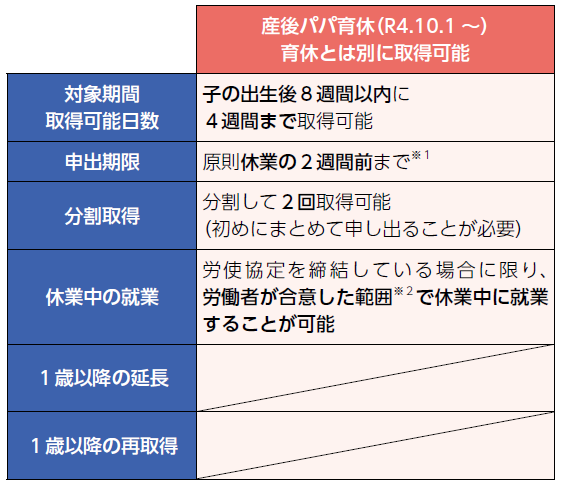
Source: Excerpted from https://www.mhlw.go.jp/content/11900000/000789715.pdf
⑤ Flexible acquisition of parental leave in parts and flexibility in the start date of parental leave (Effective October 1, 2022)
Similar to the postnatal paternity leave system, regular childcare leave can now also be taken in two separate periods. This makes it easier for workers to adjust their leave periods based on family and work situations, which is a welcome revision for employees.
Furthermore, when extending childcare leave, it has become possible to set the start date flexibly. Previously, the start date for the extended childcare leave was limited to when the child was "1 year old or 1.5 years old," but with this restriction lifted, it is now possible to start childcare leave partway through the extension period. This means that while the mother is returning to work, the father can take childcare leave, allowing couples to alternate in taking childcare leave, thus supporting a "flexible parenting life."
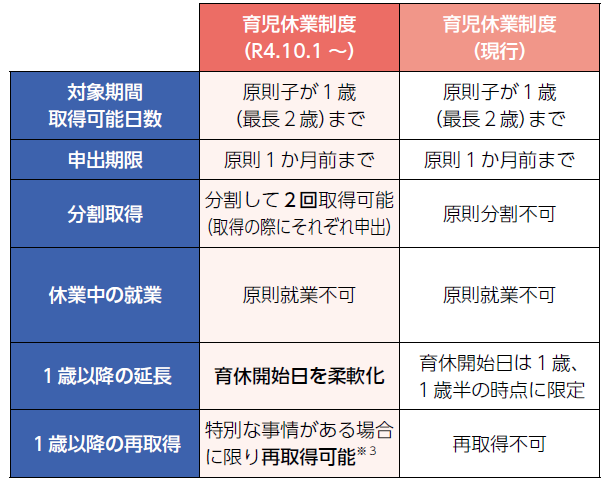
Source: Excerpted from https://www.mhlw.go.jp/content/11900000/000789715.pdf
⑥ Mandatory disclosure of parental leave acquisition status (Effective April 1, 2023)
Companies with more than 1,000 employees are required to publicly disclose the status of parental leave acquisition once a year. The disclosed content will include the "rate of parental leave acquisition by men" or the "rate of parental leave and childcare leave acquisition." The enforcement will start on April 1st of next year, but since data from the previous business year will be needed, companies must begin by understanding the status of parental leave acquisition for this year (2022 fiscal year).
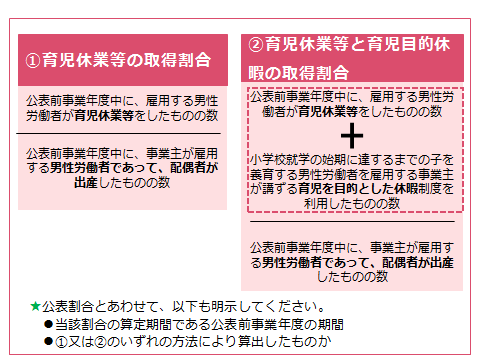
Source: https://jsite.mhlw.go.jp/tokyo-roudoukyoku/ikukai0611.html
3. How to Inform Employees About the Key Points of the Childcare and Family Care Leave Law Amendments
The Childcare and Family Care Leave Act, revised in 2021, has been gradually implemented since this year, but has sufficient awareness been provided to employees?
Childcare and family care are significant issues that everyone faces at crucial points in their lives. Therefore, it is essential for both the company and each employee to thoroughly understand the key points of the revised Childcare and Family Care Leave Act and to be equipped with the correct knowledge.
Therefore, to ensure thorough awareness, we recommend e-learning. By utilizing e-learning, which allows for learning regardless of time and place, employees can easily learn about the key points of the amendments to the Child Care and Family Care Leave Law at their convenience. Additionally, while face-to-face training can vary in quality due to factors such as the "quality of the instructor" and the environment, there is no need to worry about such issues with e-learning.
At Human Science, we provide e-learning materials that focus on maternity harassment (commonly known as Matahara), which is closely related to the Child Care and Family Care Leave Law. Currently, all businesses, regardless of industry or size, are required to address Matahara, and disciplinary actions can now be imposed on individual perpetrators. In other words, anyone can become involved in Matahara, and gaining knowledge about it is essential for all employees.
In addition, this teaching material provides a clear explanation of various systems related to pregnancy and childbirth, along with the basic knowledge of maternity harassment. It also follows the key points of the revised Child Care and Family Care Leave Act discussed in this article, allowing you to utilize up-to-date information in your internal training.
Please be sure to check this out as well.
STOP! Matahara - For Creating a Comfortable Workplace












